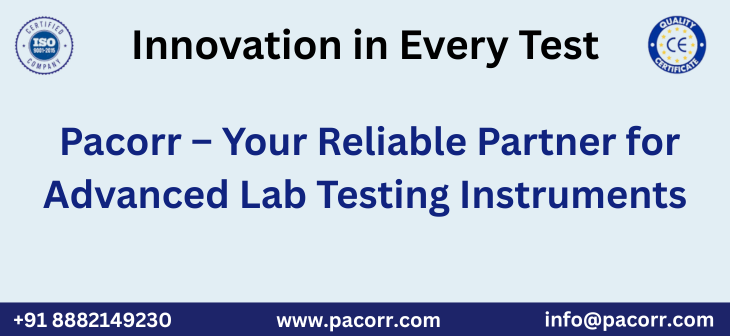
Pacorr is at the forefront of delivering cutting-edge precision measurement instruments, empowering industries to ensure high standards in product quality. In today's world of advanced manufacturing, accurate dimensional inspection is not just a necessity—it is the foundation of quality assurance. Two of the most widely used tools for dimensional analysis are the Vision Measuring System (VMS) and the Coordinate Measuring Machine (CMM). Both technologies play a vital role in quality control processes across various industries, but understanding the difference between Vision Measuring System and CMM is crucial to choosing the right tool for the job.
This blog provides an in-depth comparison of these technologies, their applications, working principles, and benefits, ensuring you make an informed decision for your metrology needs.
What is a Vision Measuring System?
A Vision Measuring System is a non-contact optical inspection machine used to capture highly accurate two-dimensional (2D) and three-dimensional (3D) measurements of an object. This system uses advanced cameras, lenses, lighting systems, and software algorithms to detect and measure features with extreme precision.
Key components include:
- High-resolution optical lens or camera
- X, Y, and Z axis motion platform
- Automated edge-detection software
- LED or ring lighting systems
Pacorr’s Vision Measuring System is commonly used in industries like electronics, medical devices, precision tool manufacturing, and plastic molding where small and intricate parts require non-contact measurement to avoid surface damage or deformation.
What is a Coordinate Measuring Machine (CMM)?
A Coordinate Measuring Machine (CMM) is a contact-based measurement device that inspects the geometry of physical objects by sensing discrete points on the surface using a mechanical probe. These probes can be touch-trigger, scanning, or laser-based depending on the measurement application.
CMMs are ideal for:
- Heavy-duty components
- Complex 3D geometries
- High-tolerance requirements in metalworking and aerospace sectors
Typically, CMMs offer very high precision for measuring prismatic parts, gears, and large components in mechanical and automotive engineering.
Difference Between Vision Measuring System and CMM
Understanding the difference between Vision Measuring System and CMM helps organizations make a strategic choice aligned with their operational requirements. Below is a detailed breakdown:
1. Measurement Principle
- Vision Measuring System: Uses non-contact optical sensors. Measurement is based on light, contrast, and edge detection algorithms.
- CMM: Employs contact probes to physically touch and detect dimensional data of the component.
2. Dimensional Scope
- VMS: Excellent for 2D and 3D analysis of small parts.
- CMM: Better suited for full 3D volumetric measurements, especially for complex and large components.
3. Contact vs Non-Contact
- VMS: Non-contact system ensures that delicate surfaces remain unharmed. Ideal for soft or elastic materials.
- CMM: Contact measurement is ideal for rigid parts where physical probing doesn’t compromise the integrity of the material.
4. Accuracy and Tolerance
- Vision Measuring System: Provides micrometre-level accuracy, best for surface features and optical contrast.
- CMM: Offers even higher accuracy with the ability to reach deep holes or complex 3D structures using extended probes.
5. Speed and Efficiency
- VMS: Faster in operation, ideal for inspecting multiple small components at once.
- CMM: Slower due to point-by-point probing, but more thorough for volumetric inspection.
6. Automation and Software
- VMS: Equipped with advanced imaging software, capable of pattern recognition, auto-focus, and programmable routines.
- CMM: Integrates with CAD models and supports parametric inspection routines but generally requires more programming.
7. Cost Implication
- VMS: More economical for small, flat, and intricate parts. Lower maintenance cost.
- CMM: Higher initial and maintenance cost, but indispensable for industries requiring ultra-high precision.
Applications of Vision Measuring System
Pacorr’s Vision Measuring System is used widely across:
- PCB and microelectronic component inspection
- Watchmaking and jewelry quality control
- Injection molded parts inspection
- Medical implant measurement
- Micro-machining and high-volume production lines
These systems are favored for their speed, accuracy, and ability to inspect without touching the specimen.
Applications of Coordinate Measuring Machine (CMM)
CMMs are ideal for:
- Aerospace components with complex geometries
- Automotive parts such as engine blocks and gearboxes
- Heavy-duty castings and machined metal parts
- Defense equipment and railways
- Large-volume 3D inspection in research and development
They are considered the backbone of precision engineering for heavy industries.
Why Choose Pacorr for Dimensional Inspection?
Pacorr offers advanced Vision Measuring Systems that are engineered for reliability, user-friendliness, and unmatched precision. Our systems feature automatic image capturing, 3D contour mapping, and programmable routines for fast and efficient inspection.
Pacorr’s commitment to innovation and customer satisfaction makes us a preferred brand in dimensional metrology. Whether you require intricate detail analysis or high-speed inspection for mass production, our optical systems deliver consistent and repeatable results every time.
Future Trends in Dimensional Inspection
The metrology industry is rapidly evolving with the integration of artificial intelligence, machine learning, and real-time data analytics. Both Vision Measuring Systems and CMMs are becoming more intelligent and autonomous. Some emerging trends include:
- AI-powered image processing for faster detection
- Integration with Industry 4.0 platforms
- Wireless data capture and IoT-enabled inspection
- Hybrid systems combining vision and contact probing
These trends underline the growing importance of choosing adaptable systems like Pacorr’s VMS that align with future smart manufacturing practices.
Conclusion
Understanding the difference between Vision Measuring System and CMM allows quality managers and engineers to select the right tool for their inspection needs. While CMMs are preferred for high-precision contact measurements on heavy and complex parts, Vision Measuring Systems offer non-contact, high-speed inspection for delicate and intricate components.
Pacorr continues to innovate in the field of dimensional metrology with robust and accurate Vision Measuring Systems tailored for modern industry demands. Whether you're in electronics, medical, automotive, or tool & die manufacturing, our advanced optical systems ensure that your measurements are always precise and efficient.
Thanks to Pacorr Testing instruments, we have all the required quality testing instruments that have helped us to ensure the best quality delivered to our clients.

Danish
Fair Exports Pvt. Ltd.

